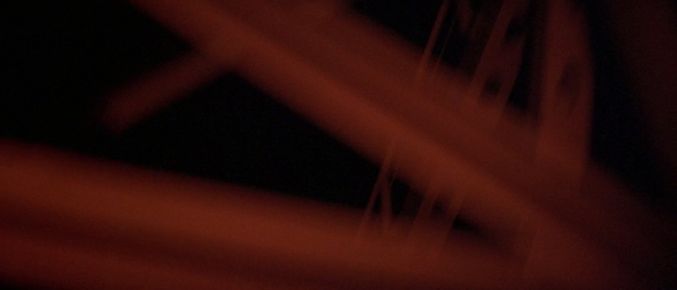 Back to selection
Back to selection
The Blue Velvet Project
Blue Velvet, 47 seconds at a time by Nicholas Rombes
The Blue Velvet Project, #104

Second #4888, 81:28
The red, terrifying beauty of the bridge truss as Frank and his gang take Dorothy and Jeffrey on a joy ride “out to the fuckin’ country.” These shots of the truss underside, bathed in light that may as well emanate from hell, are a sort of reverse-universe visual analogy of the earlier nighttime shots of the underside of trees as Jeffrey walks down his street.
In Robert Bolaño’s novel 2666, in the section “The Part about the Critics,” each of the three main characters has a different and disturbing dream on the same night:
Espinoza dreamed about the painting of the desert. In the dream Espinoza sat up in bed, and from there, as if watching TV on a screen more than five feet square, he could see the still bright desert, such a solar yellow it hurt his eyes, and the figures on horseback, whose movements—the movements of horses and riders—were barely perceptible, as if they were living in a different world from ours, where speed was different, a kind of speed that looked to Espinoza like slowness, although he knew it was only the slowness that kept whoever was watching the painting from losing his mind.
There is a palpable sense of evil to the image here at second #4888. Perhaps this has something to do with the fact that the shot presents a point of view that’s unavailable to any of the characters. This is an unusual thing, this thing that film can do with perspective. In literature, even third-person narration (which is roughly analogous to the narrative prism of most films, with notable exceptions such as Lady in the Lake [1947], The Blair Witch Project [1999], most of The Diving Bell and the Butterfly [2007] and others) often sets the scene from the general, if not literal, perspective of a specific character. Cinema, however, can jar us with a sudden break in narrative mode, which happens in this fleeting, two-second shot of the bridge truss, and which suddenly breaks the spell of the perspective in the car and in the previous sequence at Ben’s, which if not from Jeffrey’s literal point of view nonetheless captures the basics of what he sees and hears.
But in the bridge shot, we are suddenly “outside” all the characters’ point of view. It’s the sort of small but jarring shift that contributes to the disorienting violence of Blue Velvet where the characters, as Bolaño might say, were living in a different world from ours, speeding through the night in a black car with after-shock images of hell not below them but above them, in the blurred, abstract, red violence of that bridge truss.
Over the period of one full year — three days per week — The Blue Velvet Project will seize a frame every 47 seconds of David Lynch’s classic to explore. These posts will run until second 7,200 in August 2012. For a complete archive of the project, click here. And here is the introduction to the project.
